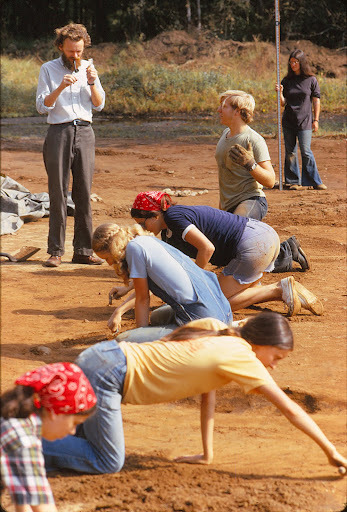A free exhibit at the University of Virginia evokes centuries of Virginia history through artifacts and other items related to Flowerdew Hundred, a property on the James River that is yielding a trove of information about an early colonial settlement and those who came before and after it.
The exhibit, “Layers of the Past: Discoveries at Flowerdew Hundred,” is open to the public during business hours through July in the main gallery of the Mary and David Harrison Institute for American History, Literature, and Culture.
It features items recovered from the Flowerdew Hundred property, a site 22 miles upriver from Jamestown that was home to prehistoric Native Americans, an early colonial fortification and mill, and later a plantation and farm. Researchers began decades of excavation work there in the 1970s, and the exhibit includes information about the property itself as well as recent scholarly research facilitated by the artifacts. Curators worked with Virginia archaeologists and Virginia Indian consultants when planning and designing the exhibit.
“The exhibition represents over 10,000 years of human history over time and space,” said Karen Shriver, curator of the Flowerdew Hundred Collection. “It was designed to give the general public and scholars an overview of the early field work conducted by the College of William & Mary, the University of California, Berkeley, and the University of Virginia, and to disseminate the latest research conducted in the last three years.”
The exhibit is drawn from a larger collection that came to U.Va. in 2008 at the direction of the children of the late David and Mary Harrison, U.Va. benefactors and former owners of the Flowerdew Hundred property. Since 1971, researchers have unearthed more than 400,000 artifacts from more than 70 different excavation sites at the property. The items date from as far back as 10,000 B.C. and as recently as the Civil War.
For the current exhibit, curators focused on the era until about 1650, selecting artifacts mostly drawn from four sites which yielded items ranging from ancient Native American stone tools to metal tools used by some of the first African slaves brought to Virginia by early settlers.
“During the 1620s, Flowerdew Hundred contained one of the most heavily defended military installations in the colony, North America's first windmill, one of Virginia's earliest examples of permanent architecture and between seven and 15 of British colonial America's first African laborers,” said Hayden Bassett, who worked with the artifacts as a U.Va. undergraduate before earning his archaeology degree from the College of Arts & Sciences in 2012. He’s now a graduate student at William & Mary as well as a co-curator of the current exhibit with Shriver and Elizabeth Bollwerk, an archaeologist who recently received her Ph.D. from U.Va.'s Anthropology Department.
“The site not only holds a significant archaeological record, but also a significant record of the discipline of historical archaeology over the past 40 years,” Bassett said. “Each new generation of researchers brings with it a body of method, theory and questions unique to the scholarship of the time. As a collection, the material will never lose its ability to enact new information about the past.”
Bollwerk said the exhibit showcases both the variety and the potential of the Flowerdew Hundred collection. Though it’s already provided researchers with many insights into Virginia history, its potential is far from spent, she said.
“The advent of new archaeological techniques and methods introduce new opportunities and possibilities for learning even more about Virginia's past from the 400,000 artifacts and hundreds of archives that comprise the collection,” Bollwerk said. “We hope the exhibit will pique peoples' interest and encourage researchers and the public alike to interact with the collection so we can continue to tap into its wealth.”
By applying new technologies and dating techniques to the existing collection, students, faculty and independent scholars could work toward groundbreaking new theories, Shriver said. The work showcases recent scholarly research – such as an analysis involving riding spurs found on the site – and staff are working to catalog the items and facilitate the next round of scholarly activity.
“Over the next year, we will scan contextual metadata, such as field notes, plan and profile drawings, photographs and files from two early 17th-century sites so that students and scholars will have online access for conducting research anywhere on Grounds,” Shriver said.
The Harrison Institute’s hours are available online.
Media Contact
Article Information
January 3, 2013
/content/flowerdew-hundred-exhibit-showcases-scholarly-wealth-potential-historical-virginia-site

